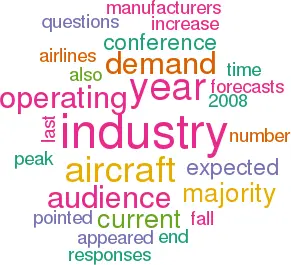Industry psychology
March 2009


The 23rd Conference on Aircraft Finance and Commercial Aviation in February saw the usual gathering of industry pundits. Overall attendance appeared somewhat down on previous years – as to be expected in the current environment – although there were more airline representatives there than usual, no doubt trying to find sources of increasingly elusive funding. Given the current dire economic environment, the overall mood of the presentations (and indeed the audience) was a bit subdued, with the notable exception of the manufacturers, and got progressively more depressed as the event developed.
The conference included a poll of audience responses to various questions surrounding forecasts. (Incidentally, it is an intriguing element of human psychology that the respondents in these events get to learn the tenor of the questions and appear to adjust their responses accordingly.)
The ten questions were posed after a brief presentation highlighting current industry forecasts (e.g. from IATA) for traffic and profitability – pointing to a $1bn operating profit for 2008 rising to a $3.9bn operating profit for the industry in 2009. Admittedly this increase is predicated on a recovery anticipated in the US industry (see last month’s Aviation Strategy) where the cuts in capacity introduced on the back of $140/bbl oil prices come into effect when demand and oil prices have slumped.
It was pointed out that the industry – like all others – is subject to the economic laws of supply and demand: supply is provided by the number of aircraft flying and the airlines available operate them; demand is represented by GDP – and on a macro basis there is no price elasticity of demand for air travel but there is elasticity of income.
Also pointed out was the historic 40% slump in aircraft production rates in previous recessions (Steve Udvar–Hazy of ILFC is suggesting a similar downturn this time – no matter what the manufacturers claim); and the level of parked aircraft in the downturn of 2001–02 when 12% of the world’s fleet was resting in the desert. Interestingly recent figures from Ascend show that 12% of the world’s operating aircraft fleet was once again parked at the end of 2008.
In the series of attached tables we show the results of the poll. The conclusions are that the audience was generally pessimistic but maintained some glimmer of hope. A majority believed that there would be no increase in the number of aircraft mothballed this year; that the values of short haul aircraft would only fall by 20% from the recent peak and yet that the manufacturers would continue at production rates less than 20% below the peak by 2012. Anomalously perhaps the majority also expected a fair current value of a short haul jet to have fallen by 25% by the end of the year.
On the demand side the audience appeared more pessimistic, with the majority believing that IATA was being too optimistic and that passenger demand would fall by more than 4% this year – with a sizeable minority expecting declines of over 6%. A third believed that industry revenues in 2009 would decline by more than 7.5% year on year.
It is hardly surprising therefore that industry operating profits this year were expected to fall into the red (with a reasonable minority expecting operating losses in excess of $10bn) even though this would represent an unprecedented negative operating margin (maybe they were thinking of net profits), and would put paid to any recovery in the US.
It has been widely reported that 30 airlines went bankrupt last year, mostly all relatively small carriers. The majority expected an increase in failures this year – and a similar number of airlines receiving government aid.
Throughout the conference there was much discussion of the possible shape of this current global recession: V–shaped, Ushaped or (as one guru stated) swimming–pool- shaped (have we dived into the deep or the shallow end?)
Economist Anatole Kaletsky pointed out that this (as every) recession is different; but truly so in that unprecedented and divergent forces are in play that make forecasts from econometric models – that rely on precedent to predict the future – virtually impossible. Some 20% of the audience seemed to believe that industry revenues would return to the 2008 peak by 2010 (the 'V's?) and a 53% majority by 2011 (the 'U's?).
The consensus appeared to be that the world and the industry is in for a long difficult period. It is almost a truism to say that the top of the cycle is marked by people saying that “this time is different” and that it is going up forever. The converse is also valid – but it always feels worse because fear is a more fundamental emotion than greed. Nevertheless at the polling session at last year’s conference the audience responses were patently too optimistic. We might hope that this time they are in the opposite direction.